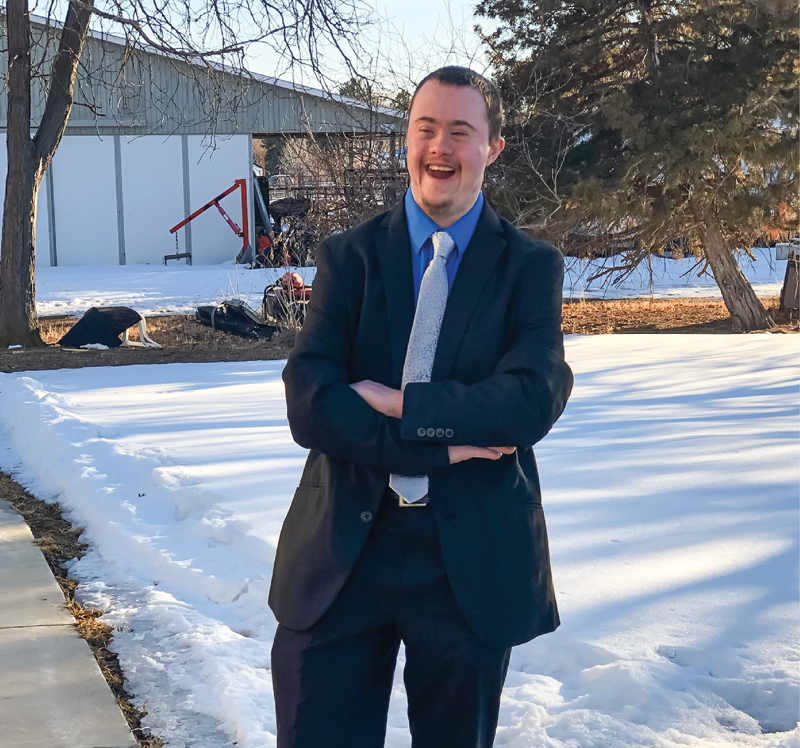Travis Rice spent most of his life being tired.
Even when he was 8 years old, a time when most boys can exhaust their teachers, parents and pets, sometimes in the same day, Patty Rice had to drag Travis off the couch in the afternoons before sports practices. Sports gave Travis joy. He loved to play basketball, softball and bowling in the Special Olympics. But he seemed to prefer naps on the couch in the afternoon. Patty, his mother, who lives in Berthoud, was persistent only because she knew how much he loved the games once he was there.
Travis has Down syndrome, but being sleepy all the time wasn’t really considered one of the challenges he was supposed to face.
“He had these bags under his eyes, some deep bruising,” Patty says. “It just seemed to be on a different level, and it didn’t get any better as he got older.”
Patty tried to find some solutions. She even put him through allergy tests, 120 “pokes” in all, and doctors found none, not even a minor one. He went on being tired well into adulthood.

Travis and his mother, Patty Rice.
And then, nearly three years ago, when Travis was 27, Patty’s doctors asked her a question: Does Travis snore?
Oh, man, did he ever.
“When he was younger, he would sleep in the same area as us,” Patty says. “He snored like a freight train. He was very loud.”
Siavash Panah, a pulmonologist and sleep physician with Banner Health, had seen this before: Sleep apnea is a common problem for those with Down syndrome. Sleep apnea occurs when your breathing stops and restarts while you sleep. Age and obesity are risk factors, but some believe it affects as many as 80 percent of those with Down syndrome, says Panah. The facial structure commonly seen among those with Down syndrome usually creates a collapsible airway when breathing and sleeping at night, a classic cause of apnea.
Patty was stunned by the diagnosis.
“Apnea was one of the last things on my mind,” she says. “He was just a little kid when this started.”
Many others don’t think of sleep apnea. As high as 10-20% of the population may have it, Panah says, and of those, 80% don’t realize they have it.
The condition does more than cause snoring. It significantly increases the chances of a stroke and heart attack, and the chronic weariness may be the worst part, as those with sleep issues struggle with energy throughout the day. Depression, for instance, is common in those with sleep problems.
Travis, however, did find some help, and the cure is a unique one. Doctors believe he’s the first patient with Down syndrome in Northern Colorado to have the Inspire device implanted as a treatment. Doctors place the device in your body, opening the airway and allowing you to breathe normally during sleep. He had the surgery in May 2022.
Inspire is the only implant in the U.S. that does this, although Europe does have other devices.
The common treatment for apnea is a mask you wear at night that delivers air pressure to prevent the airway from collapsing. They look like something doctors strap on to you to give you sleeping gas, or perhaps the mask Hannibal Lecter wore in “Silence of the Lambs.” They aren’t the kind of thing anyone wants to wear to bed, let alone someone with Down syndrome.
“Putting a mask on your face and sleeping doesn’t sound comfortable, but some can override it,” Panah says. “They know they will feel better if they do wear it. That level of mental override isn’t possible for most with Down syndrome.”
The few who can, Panah says, may still take it off in the middle of the night, when they aren’t at their sharpest. And there are also tasks associated with the mask, such as cleaning it, that require a vigilance Down syndrome patients may not have. Some may also just simply forget to put it on when they go to bed.
The mask, Patty confirms, wasn’t possible for Travis. And she was relieved to hear about Inspire.
“He’s much more rested and wants to do stuff,” she says. Travis, who also likes playing Pokémon and listening to music, says he feels better during the day.
“I’m not sleepy anymore,” he says.
Inspire’s first patients received the implant a decade ago, but it’s still not too common, as just 50,000 in the U.S. have received them.
“The discriminating factor is that it’s a surgical device,” Panah says, “and the overall expense is higher than a mask.”
It’s so successful in Down syndrome patients, however, that Inspire is seeking out special approval for pediatrics with Down syndrome, as right now you have to be 18 to receive it.
Parents who have children with Down syndrome should almost count on them dealing with sleep apena, Panah says, but Inspire could save their quality of lives, if not their lives overall. Down syndrome patients typically live longer because of breakthroughs such as Inspire, doctors believe.
“This procedure altered the course of Travis’ life,” Panah says.
It may have even made it possible for Travis to become more independent. That’s something Travis wants as well, Patty says. One day, he could live on his own.
“It will be my goal at some point to have him in an apartment with someone else,” Patty says. “Time will tell.”
_______________________________________
Dan England is NOCO Style’s assistant editor, and a freelance journalist based in Greeley.

